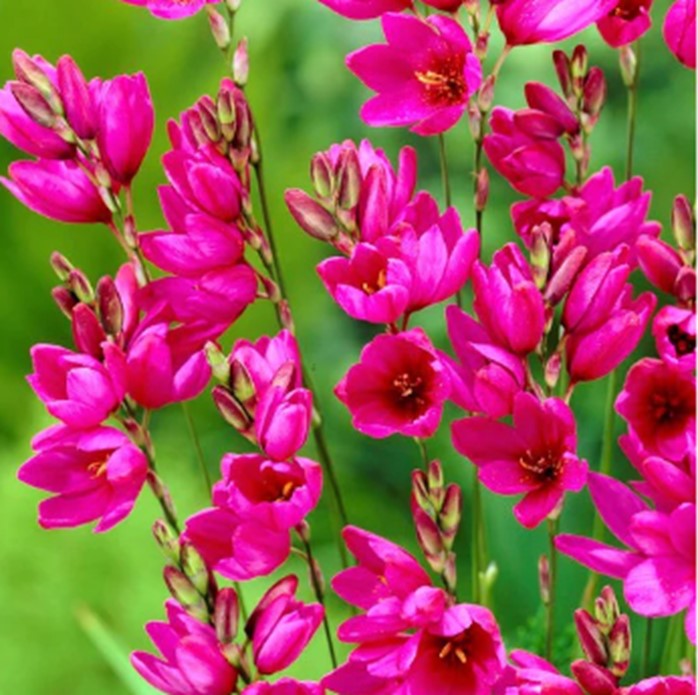Ixia species is commonly grown for its showy clusters of star-shaped flowers borne on thin, wiry stems. Ixia flowers from spring to summer and comes in a range of bright colors– orange, pink, red, white, and yellow with contrasting centers.
Ixia species is commonly called ixias, corn lilies, and wand flowers. Individual blooms have six petal-like tepals. Flowers appear on long, loose spikes above grass-like mostly basal leaves. A few small leaves appear on the long flowering spikes. Flowers are arranged in two ranks or rows.
Ixia is grown from corms. Corms will rot if left in wet soil, especially in winter. Plant Ixia on mounds in regions where there is plentiful rainfall.
As a proud grower of gorgeous African corn lily flowers, I know how disheartening it can be to see these beautiful blooms start rotting away. However with some care and preventative measures, you can avoid the rot and keep your African corn lilies thriving. In this article I’ll share my top tips for preventing your precious African corn lily flowers from rotting.
Understanding Why Rot Occurs
Before jumping into prevention strategies, it’s important to understand what causes African corn lily flowers to rot The main culprit is overwatering, which creates overly damp soil conditions that encourage fungal growth and decay. Insufficient drainage, humidity, crowded plantings, and diseases like botrytis can also lead to rotting. Being aware of these factors will help you take steps to avoid them.
Tips to Prevent Rot in African Corn Lilies
Here are some effective ways I’ve found to protect my African corn lily flowers from rot:
-
Water carefully – This is key! Water only when the top inch of soil is dry. Make sure pots have drainage holes and beds have good drainage.
-
Provide good airflow – Give plants ample space and avoid crowded planting. Prune foliage to enhance air circulation.
-
Choose well-draining soil – Grow in sandy, loam mixes. Amend heavy clay soils with compost or perlite.
-
Add mulch – An organic mulch inhibits fungal spores in soil. Avoid touching stems with mulch.
-
Monitor soil moisture – Check soil frequently, especially if humidity is high. Allow overly damp soil to dry out before watering again.
-
Discard diseased debris – Remove any rotten or diseased foliage promptly. Disinfect tools after pruning diseased plants.
-
Find the right spot – Plant in full sun in a warm, dry spot with good airflow. Move containers to ideal conditions.
-
Space plants properly – Avoid overcrowding to encourage air circulation and reduce humidity levels.
-
Use drip irrigation – Drip systems deliver water right to the soil without getting foliage wet.
-
Use fans if needed – Improve air flow with oscillating or ceiling fans if humidity is persistently high.
What to Do if You See Rot
If you notice any soft, discolored or foul smelling leaves or stems on your African corn lilies, act quickly! Prune out all affected parts of the plant well below the rotted area. Remove any fallen plant debris and destroy it. Use a fungicide drench if fungus is severe. Space plants further apart and improve air flow. Avoid overwatering while the plant recovers.
Enjoy Gorgeous African Corn Lily Flowers

Planting and spacing Ixia – Corn Lily
- Set corms 2 to 3 inches (50-75mm) deep in the garden.
- In pots, plant Ixia 1 inch (2.5cm) deep.
- Space Ixia 3 to 4 inches (7.5-10cm) apart.
How to water and feed Ixia – Corn Lily
- Keep the soil evenly moist but not wet; they should never be wet or completely dry.
- Fertilize Ixia with an all-purpose fertilizer during the growing season.
- Ixia growing in containers should be fed a dilute, balanced fertilizer every two weeks through the growing season.
Ixia viridiflora, flower buds
How to plant a pot of Ixia (corn lily)
FAQ
What is the vase life of African corn lilies?
Do Ixia come back every year?
When to plant African corn lily bulbs?
Should I soak Ixia bulbs before planting?
How do you care for African corn lilies?
African corn lilies require regular watering, especially during the growing season. Water the plant deeply but infrequently, allowing the top inch of soil to dry out before watering again. Fertilize the plant every two weeks with a balanced liquid fertilizer, diluted to half strength. Stop fertilizing in the fall when the plant goes dormant. 5.
What is an African corn lily?
The African corn lily, scientifically known as Ixia, is a captivating plant that adds vibrancy and charm to any garden or indoor space. With its striking flowers and easy-care nature, it’s a popular choice among gardening enthusiasts.
How to propagate African corn lily?
The propagation of this plant is also done through seeds; however, it might take three years or more for them to bloom. The Ixia flower seeds should be covered with soil once the last spring frost has passed. The African corn lily also propagates naturally through insects and bees.
Can You Grow African corn lily outside?
The African corn lily, scientifically known as Ixia, is a captivating plant that adds vibrancy and charm to any garden or indoor space. If you’re growing the plant outdoors, dig up the corms in the fall before the first frost and store them in a cool, dry place.
